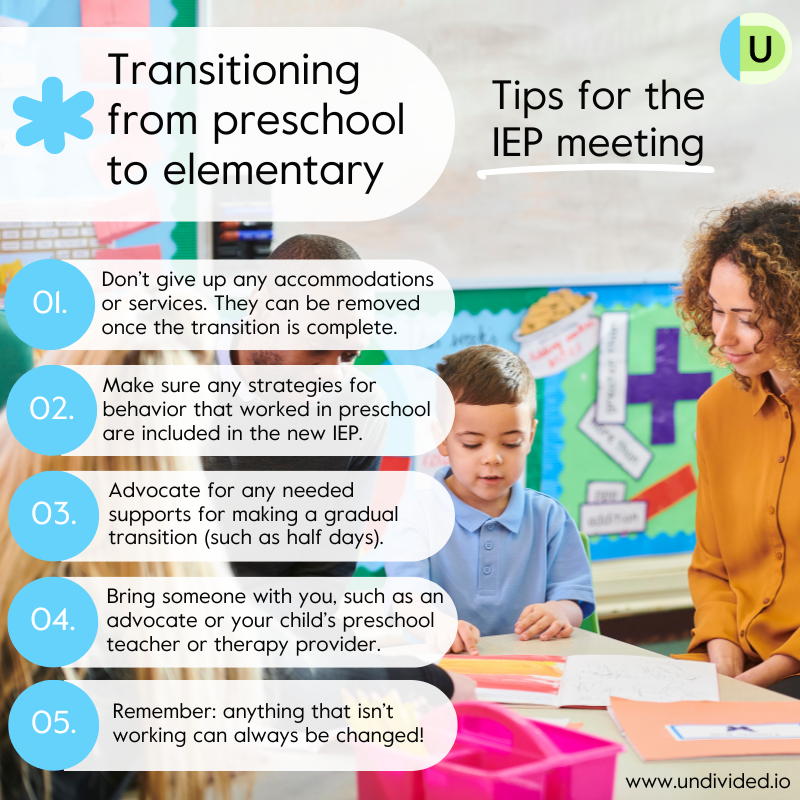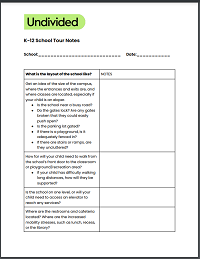Making the Transition to Kindergarten with an IEP
The transition from preschool to kindergarten, elementary to middle school, and middle to high school are rites of passage, and while they can be equal parts thrilling and terrifying for students and parents alike, these transitions often come with extra challenges for kids with disabilities and their families. This series looks at ways to make these leaps as painless as possible.
Watching your child emerge from the playful days of preschool and take their first steps toward “big kid” status in kindergarten can be tough (and is often tougher on us than it is on our kids!). But it's a move to take seriously, as kindergarten can set the tone for their entire elementary school experience. For many kids, kindergarten is the first exposure to a more structured curriculum, and the academic environment (and expectations) can be stressful. If your child is transitioning to a public elementary school, the sheer size of the building and number of other students can also be overwhelming. With all this in mind, we reached out to Dr. Sarah Pelangka, special education advocate and owner of Know IEPs, as well as three seasoned parent advocates in our community to find out how we can help our kids (and ourselves) prepare for the big transition.
School tours and observations
Even if you’re happy with the elementary school in your catchment area, it’s important to take a tour so you can get a sense of the teachers, the classroom, and how well students with disabilities are (or are not) included. (And if you’re unfamiliar with your home school, tour it and every other school you think might be an option!) Keep the following in mind when taking school tours and/or observing classrooms:
Ask to see a general education classroom, even if your child will likely not be learning there.
Ask to see a Special Day Classroom (SDC), if that’s a possibility for your child. Pay attention to how many adults are in the room. Does it seem to be enough, or are they short-staffed? It's often that there are too many adults in the room and it's overwhelming.
Are kids with IEPs segregated or separated at any point during the school day? One example could be Adaptive Physical Education (APE). If APE is separate from general education PE, ask to see those areas AND the GenEd areas to see if they are vastly different.
Similarly, inquire about the technology and equipment used in special education classrooms. Sometimes tech and computers are worse in the special education classrooms, or there are none at all.
- Does your child need assistance in the bathroom or require diaper changes? If so, where will this be done? Make sure the proper privacy is provided to them so that other children (or adults) cannot walk in and see.
Get an idea of the size of the campus, where the entrances and exits are, and where classes are located, especially if your child is an eloper. Are any gates broken or designed so that they are easy to push open from the inside?
What does inclusion look like? Observe how the teachers interact with the students (in any setting), and more importantly, whether kids with IEPs are truly included in the same activities at the same time in the same place with the GenEd students.
What speech and vision supports are provided in classrooms?
If your child has auditory sensitivities, pay attention to the classroom acoustics. If your child has trouble staying focused, pay attention to the environment. Are there a lot of distractions (e.g., an adjacent playground, doors and windows left open, etc.)?
Where are the increased mobility stresses, such as lunch, recess, or the library? Consider a physical therapy assessment if your child may have difficulty navigating a bigger school.
Are the playground and field accessible? If your child uses a mobility aide, they may need an adaptive trike to access those outdoor areas.
If you can, try to observe classrooms on two different days at different times, no matter the classroom type. For example, circle time in the morning might look great, but how does math look after recess?
The best you can do for yourself is take the time to make sure both you and your child are comfortable with the school you choose, as it’s often hard to change schools once they’ve started.
For a handy chart you can print out and bring with you to take notes, see our school tour checklist for Undivided members.
Kindergarten pre-assessments
One of the things you’ll discuss at your transition IEP meeting is which assessments your child may need prior to entering kindergarten. These can include psychological assessments and assessments for speech, occupational therapy, physical therapy, and more. Take into consideration whether you want to request that the assessments take place in person or virtually, which could affect the results.
Parents should also spend time outlining what worked for their child in preschool — both from their perspective and the district’s. It would be a missed opportunity if the knowledge gained from two years of problem-solving in preschool gets lost when they make the jump to kindergarten.
The transition meeting
The transition IEP meeting is obviously the most important (not to mention nerve-wracking) part of the process, so you want to make sure of a few things:
Don’t give up any accommodations or services. No matter how well you vet a new school, you can never truly know all the ins and outs until your child starts attending, and therefore can’t know for sure what supports they might need. Until the transition actually happens, do not give up any services (such as OT or speech therapy) that the school might feel your child doesn’t need — the same goes for accommodations. (Here’s a comprehensive list of accommodations.) Services or accommodations can be removed once the transition is complete if they are truly no longer needed. Remember to ask how the services will be applied as well. Some pull-out services could and should be considered for push-in instead (administered within the classroom as opposed to in a private or resource room).
Maintain high academic expectations. Consider creating a vision statement for your child that clearly describes their strengths — a strength-based IEP can make all the difference in helping the IEP team determine which goals and accommodations will best support your child in achieving what they’re capable of. But don’t stop there! Read up on how you can make sure your child’s IEP goals are based on common core standards.
If it ain’t broke, don’t fix it. Make sure any processes or strategies that worked in preschool are included in the new IEP. This can include anything from safeguards against elopement to something more granular, like five-minute warnings when transitions will happen. These notes can be included under the IEP’s parental notes or concerns section, and will help establish a recognized continuity for your child that will help them be more comfortable and successful.
Establish the best setting. What type of kindergarten classroom is going to achieve the least restrictive, most appropriate environment? And should it be worked up to, rather than jumped into? Kindergarten is often the first opportunity to gain access to GenEd or inclusion, which can be a challenge to advocate for. For example, if your child is not fully toilet-trained yet, that should not exclude them from a GenEd setting. If there are other medical issues or concerns about their ability to sustain a longer day with higher demands (more rules, more classmates, longer days, no naps), some districts might allow the child to start the first few weeks with half days. If your child struggles upon transition, or you know they will probably exhibit behaviors, don’t be afraid to request a functional behavior analysis (FBA) within the first few weeks of school starting. This allows you to assess possible reasons behind the behaviors and to add supports rather than being pushed to an SDC.
Plan ahead. The transition process might take longer than you anticipate. If you think there might be a placement issue, work with your school district to schedule your child’s transition IEP for March or April rather than June so that you have plenty of time to resolve any disagreements.
Never go alone. Consider hiring an advocate if inclusion is an important element for you and you’re not sure how best to integrate it into the IEP. But if that’s not an option, bring along the preschool provider and/or any other outside service providers, such as in-home ABA therapists. Their input is always beneficial, and gives you another set of ears in the room (on your side of the table).
Finally, it’s always a good idea to record your IEP meeting, transition or otherwise; note that you must inform the school 24 hours in advance of your intent to record the meeting. Try to have all your questions and concerns written out (and your vision statement, if you prepared one) and send it to the IEP team a few days prior to the meeting. You’ll be more likely to receive thorough, honest, and detailed answers when team members have had the opportunity to prepare.
And remember that anything that isn’t working can always be changed! You have the right to call an IEP meeting at any time, no matter the transition stage of your child.
For a step-by-step guide with all these expert tips, templates, organizational tools, and more, add this goal to your Undivided account!
Transition to elementary school
Join for free
Save your favorite resources and access a custom Roadmap.
Get StartedAuthor




